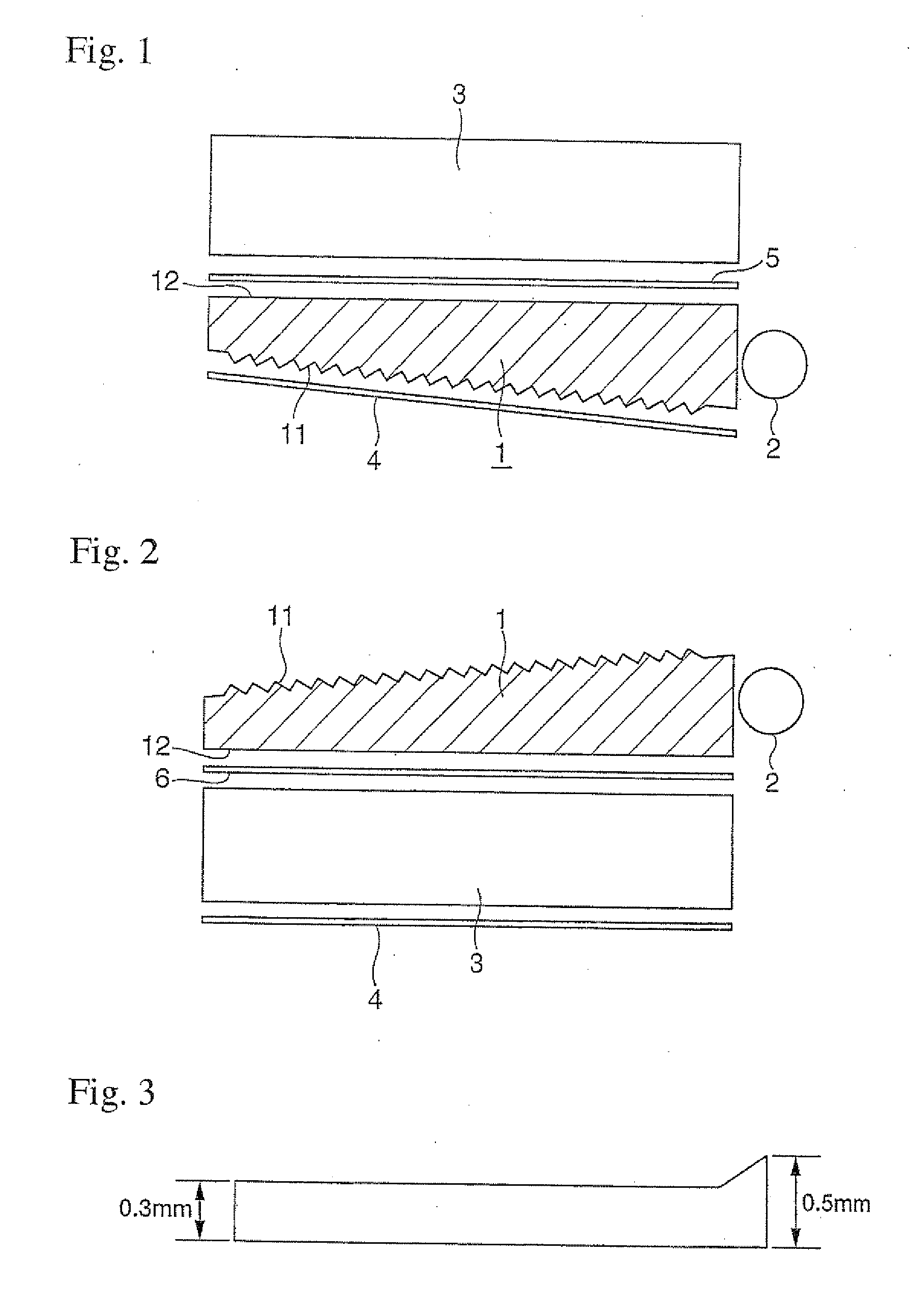Aromatic polycarbonate resin composition for light guide plates, and light guide plate
a technology of aromatic polycarbonate resin and composition, which is applied in the direction of synthetic resin layered products, instruments, other domestic articles, etc., can solve the problems of high temperature exposure of the inside of the device, inability to completely fill the mold cavity with molten thermoplastic resin, and inability to ensure good fluidity, etc., to achieve excellent fluidity, good mechanical properties, good light transmittance and thermal stability, good mechanical properties
- Summary
- Abstract
- Description
- Claims
- Application Information
AI Technical Summary
Benefits of technology
Problems solved by technology
Method used
Image
Examples
production example 1
Production of Aromatic Polycarbonate Resin
[0121]8.00 kg (35 mol) of 2,2-bis(4-hydroxyphenyl)propane (BPA) and 50 g of hydrosulfite were added to 34 L of a 8% (w / w) sodium hydroxide aqueous solution, and dissolved therein. The resultant solution was mixed with 11 L of dichloromethane. While maintaining the obtained solution at 20° C. under stirring at a reverse rotating speed of 180 rpm using an agitator manufactured by Shimadzu Seisakusho Co., Ltd., 4.0 kg of phosgene was blown into the solution over 30 min.
[0122]After completion of blowing the phosgene, 6 L of a 8% (w / w) sodium hydroxide aqueous solution, 14 L of dichloromethane and 404 g (2.7 mol) of p-tert-butyl phenol were added to the obtained reaction solution, and the resultant mixture was violently stirred at a reverse rotating speed of 210 rpm to allow the mixture to be emulsified. Thereafter, the obtained emulsion was mixed with 10 mL of triethyl amine as a polymerization catalyst and polymerized for about 1 hr.
[0123]The t...
production example 2
Production of Aromatic Polycarbonate Resin
[0124]Using a continuous production apparatus constructed of four vertical stirring reactors and one horizontal stirring reactor which were controlled under the following conditions, the aromatic polycarbonate resin was produced by a melting method.
[0125](First vertical stirring reactor): 140° C.; normal pressures
[0126](Second vertical stirring reactor): 220° C.; 13.3 kPa
[0127](Third vertical stirring reactor): 240° C.; 2 kPa
[0128](Fourth vertical stirring reactor): 255° C.; 93 Pa (Fifth horizontal stirring reactor): 255° C.; 93 Pa
[0129]First, in the raw material preparation step, bisphenol A (BPA) and diphenyl carbonate (DPC) were mixed with each other in a nitrogen gas atmosphere at a predetermined molar ratio (DPC / BPA 1.15), and the resultant mixture was heated to 140° C., thereby preparing a mixed raw material melting solution.
[0130]Successively, the thus prepared mixed raw material melting solution was continuously fed to the first vert...
production example 3
Production of Aromatic Polycarbonate Resin
[0133]The same procedure as defined in Production Example 1 was conducted except that 404 g (2.7 mol) of p-tert-butyl phenol was added simultaneously with addition of 11 L of dichloroethane, but no p-tert-butyl phenol was added after completion of blowing the phosgene, thereby producing an aromatic polycarbonate resin. As a result of subjecting the obtained aromatic polycarbonate resin to measurement of viscosity and GPC analysis, it was confirmed that the aromatic polycarbonate resin (hereinafter referred to merely as “PC-3”) had a viscosity-average molecular weight (Mv) of 14,000 and a ratio Mw / Mn of 2.9, and the content of low-molecular weight polymer having a molecular weight of less than 1,000 in the resin was 2.6%.
PUM
| Property | Measurement | Unit |
|---|---|---|
| temperature | aaaaa | aaaaa |
| thickness | aaaaa | aaaaa |
| length | aaaaa | aaaaa |
Abstract
Description
Claims
Application Information
 Login to View More
Login to View More - R&D
- Intellectual Property
- Life Sciences
- Materials
- Tech Scout
- Unparalleled Data Quality
- Higher Quality Content
- 60% Fewer Hallucinations
Browse by: Latest US Patents, China's latest patents, Technical Efficacy Thesaurus, Application Domain, Technology Topic, Popular Technical Reports.
© 2025 PatSnap. All rights reserved.Legal|Privacy policy|Modern Slavery Act Transparency Statement|Sitemap|About US| Contact US: help@patsnap.com



